Written by Kent Patterson
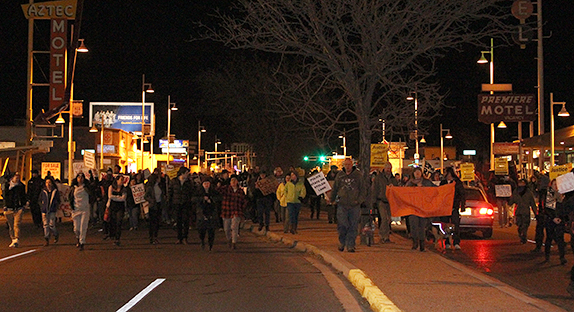
Like more than one hundred U.S. cities, Albuquerque, New Mexico, witnessed forceful protests following the decision of a Missouri grand jury to not indict officer Darren Wilson for shooting to death unarmed African-American teen Michael Brown last August.
Out for a second day of demonstrations, scores of protesters had gathered at the corner of San Mateo Boulevard and Central Avenue in the heart of the Duke City by 6:15 pm on November 25.
Convened by (un) Occupy Albuquerque, the racially-mixed crowd beat a drum, chanted “No Justice, No Peace” and waved signs that read “Black Lives Matter,” “Justice for Michael Brown” and “Indict officer Keith Sandy,” the latter demand in reference to an ex-Albuquerque Police Department (APD) cop who was one of the two policemen involved in shooting to death homeless camper James Boyd in the Sandia foothills last March.
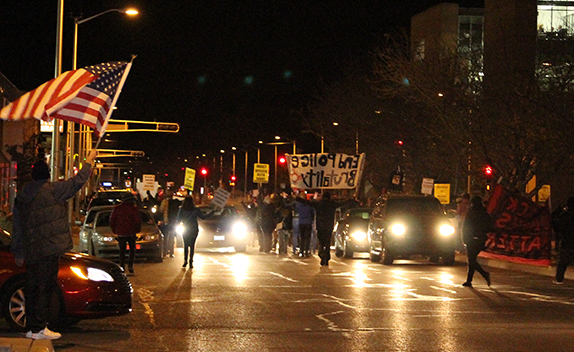
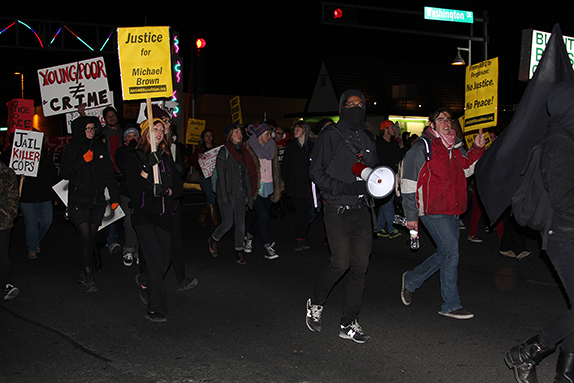
“I’m here to protest, to vent my frustration and anger for the failure to indict officer Darren Wilson for the murder of Michael Brown,” protester Carlyn Pinkins told FNS.
Asked if she saw any parallel between Albuquerque, where the city government and U.S. Department of Justice recently agreed to a consent decree mandating APD reforms after years of police shootings, and Brown’s hometown of Ferguson, Missouri, Pinkins said “structures” in both cities shield the police.
“They are not held accountable like other citizens and that has to stop” Pinkins said. “I think it’s time for our federal government and our state governments to do something before this gets us.”
Pinkins, who is African-American, added that it was “significant” that people of different races turned out for the Albuquerque protest.
Relatives of men shot to death by APD in previous years were among the protesters standing their ground on a frigid night. Theresa James, whose partner Jay Murphy Sr. was killed in 2007 by APD, called Ferguson a “terrible situation” which was necessary to protest.
Locally, James said she detected some progress in police practices, pointing to two recent SWAT stand-offs that ended without suspects being shot. “I think the officers are trying,” she said.
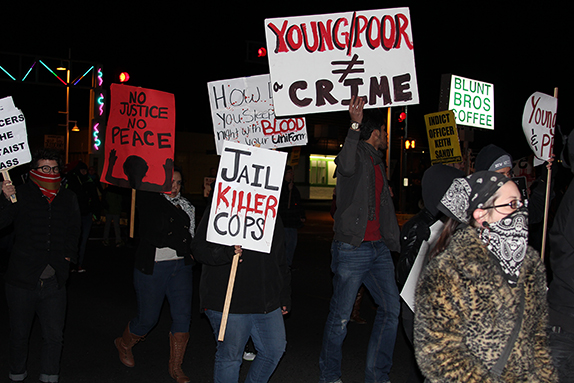
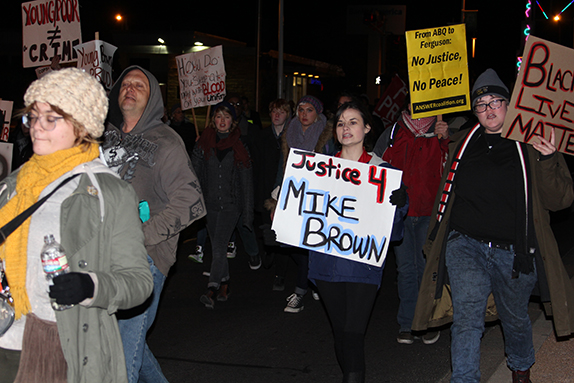
Nora Tachias Anaya, whose nephew George Levi Tachias was shot to death by APD back in 1988, expressed concern about the rapidly evolving shift in the protest. “We want a peaceful protest. We don’t want any problems with APD.”
To the surprise and concern of some protesters like Tachias Anaya, demonstrators began blockading the busy, pre-Thanksgiving holiday intersection at San Mateo and Central. Prevented from moving, frustrated motorists honked their horns as one woman shouted “idiots” along with the expletives deleted at the demonstrators. Some drivers attempted to run the blockade, creating tense moments.
Almost spontaneously, voices rose from the protest urging the crowd to begin marching down Central, the old Route 66 or musical Mother Road of truckers, Dust Bowl refugees and California dreamers.
Flanked by traffic cops rerouting traffic as helicopters buzzed overhead, protesters marched west on Central, chanting “Hands up, don’t shoot!, and into the University of New Mexico area as their numbers seemed to grow larger and their faces younger. Queried about the march’s destination as it rolled past campus, a young protester simply said wherever it ends.

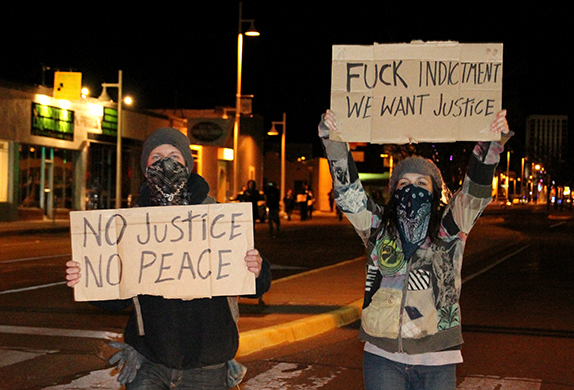
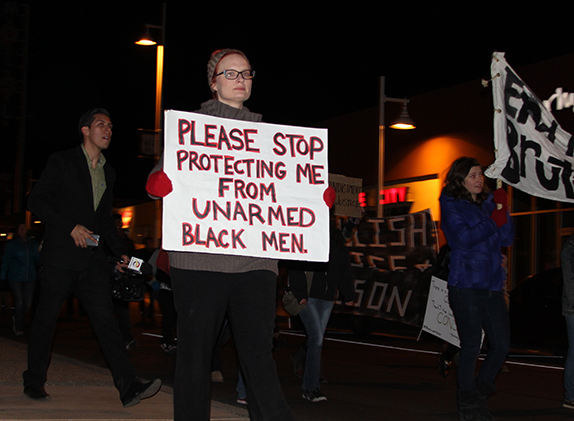
The Central Avenue takeover recalled last spring’s action in the wake of the James Boyd shooting. The big difference this time was the lower police profile. Unlike last spring when APD and other law enforcement agencies hauled out a military-style force bolstered by armored vehicles, tear gas, horsemen and automatic rifles, the cops largely stayed in the background and allowed the marchers to proceed unmolested.
Suddenly, the march detoured into the remnants of Yale Park, the historic gathering place of the old youth counterculture in front of UNM that was later largely razed and rebuilt as a university bookstore. More tense moments transpired between protesters lingering in the street and motorists, one of whom was briefly trapped by a handful of hood-banging protesters as he tried to force his truck through the demonstration.
“I know you guys are in the protest and that’s awesome!” shouted a young woman leaning out of her black Volkswagen bug. “But I’m trying to move!”
Prior to resuming their march, the protesters sat down in old Route 66 in a 4.5 minute silent tribute to Michael Brown, choosing the time in memory of the 4.5 hours Brown’s body lay in a Ferguson street after he was killed by Darren Wilson. Oblivious to the call for silence, two beefy men in a Silverado cranked up a corrido and veered their big truck around the sit-in.
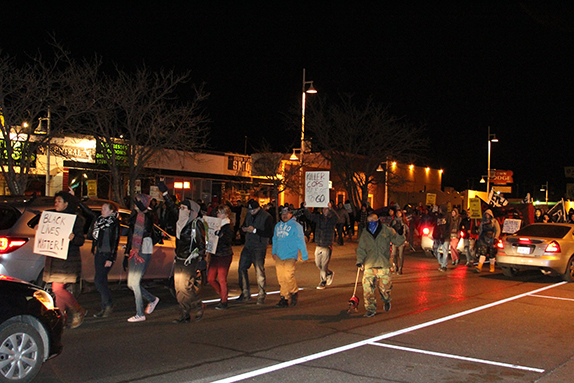

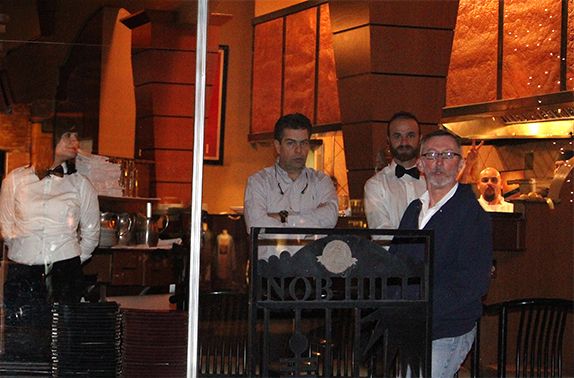
Across from Yale Park, a protester displayed a message with a quote from a famous Black leader of the 1960s: “There is a higher law than the law of government. That’s the law of conscience. Stokely Carmichael.”
Scurrying about the scene accompanied by a Zia sun New Mexico state flag, ABQ Justice’s Dinah Vargas delivered a litany of messages to protester and passerby alike. “We got a just cause,” Vargas boomed. “We all saw James Boyd being murdered.”
Melina Juarez held a large placard mainly written in Spanish that connected two seemingly distant places: Translated into English, it read: From Ferguson to Ayotzinapa: One struggle. Enough is enough. Not one more.”
In remarks to FNS, Juarez said Ayotzinapa referred to the Mexican students from the rural college who are “fighting injustice” while facing great state repression. “In Ferguson, just being a black person is seen as a threat to the state,” she contended.
Juarez is not alone in making the U.S.-Mexico connection. Student protesters who’ve occupied University of California buildings during the last week in a protest against a new round of proposed tuition hikes have posted a chart on the Internet that shows Ayotzinapa and Berkeley as among the places immersed in a global struggle for public education.
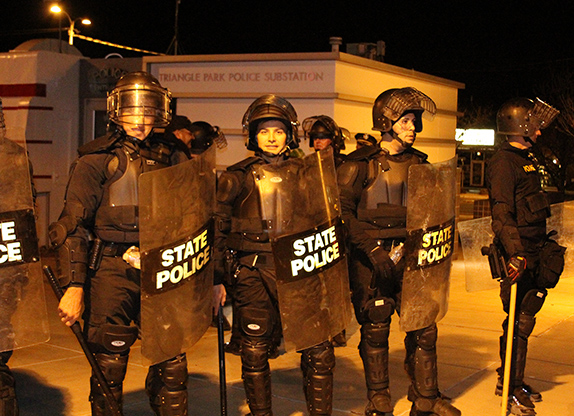
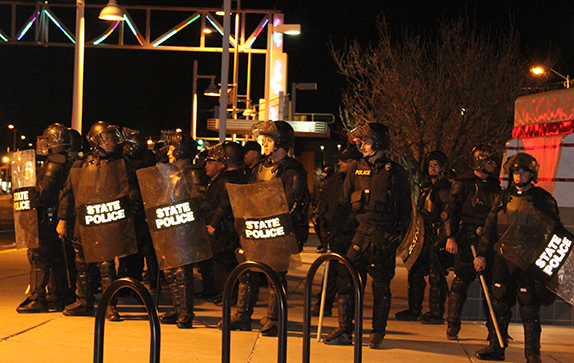
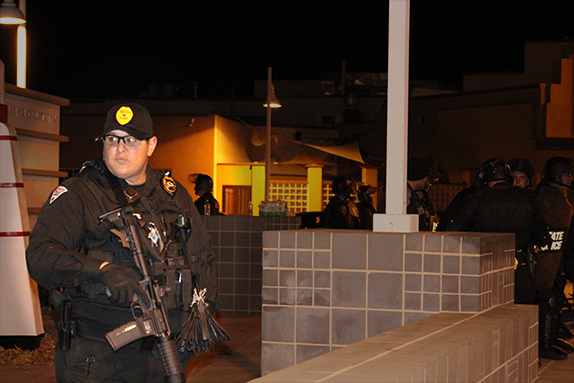
The Mexican media outlets El Universal, La Jornada and El Diario de Juarez, which have been stuffed with stories for weeks about the national uprising stemming from the police killings and forced disappearances of Ayotzinapa students, have played up Ferguson as a prominent story in the last couple of days.
For Carlyn Pinkins, international historical precedents and national tendencies have a bearing on both Ferguson and Albuquerque.
What’s happening in Ferguson and Albuquerque is not isolated,” she said. “There’s a national trend of police acting against their citizens everywhere.” Pinkins said events in the two cities are indicative of a fraying of the social contract between the state and its citizens, a development which historically has led to upheavals like the French and Russian revolutions.
“Nationwide, if things don’t change, I think you’ll see that social contract completely break down or deteriorate significantly,” Pinkins predicted.
(Photos by Benito Aragon)




Responses to “Albuquerque Protesters Occupy Old Route 66”